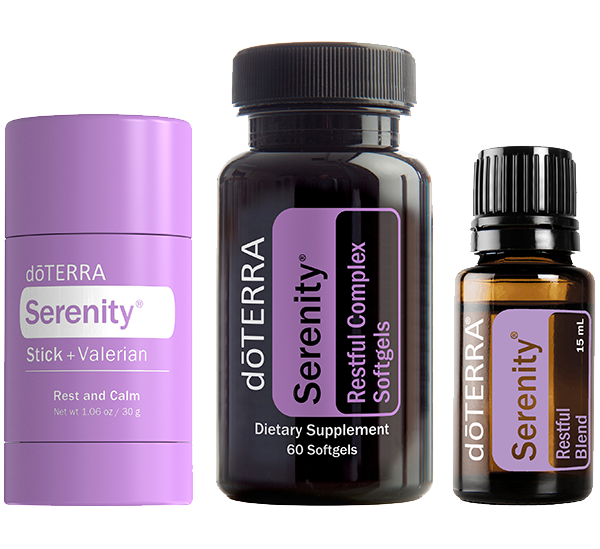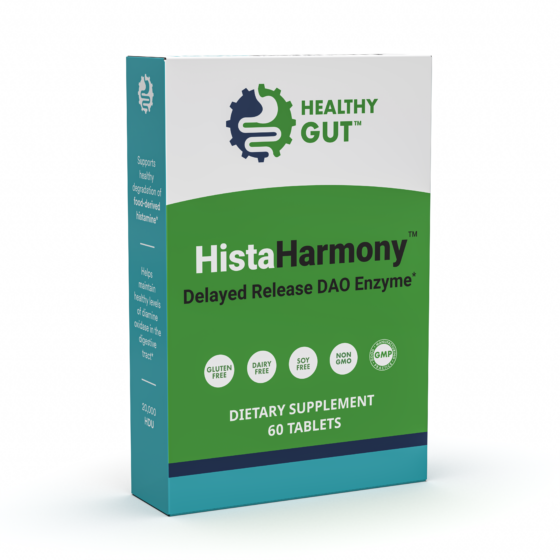What are the Symptoms of Histamine Dumping?
Have you ever woken up suddenly at 3:30 or 4:00 AM with a pounding heart, a dull headache, or a feeling of restlessness that makes it impossible to go back to sleep?
Maybe you push through the next day with brain fog, extreme fatigue, and a migraine that won’t quit.
If this sounds familiar, you may be experiencing histamine dumping—a term used to describe a surge in histamine that happens when the body fails to regulate it properly, especially during the night.
Histamine, a neurotransmitter and immune system mediator, plays a key role in sleep, digestion, immune response, and even hormone balance. But when your body releases too much histamine or fails to break it down efficiently, it can cause a range of symptoms that disrupt sleep and leave you feeling exhausted the next day.
I know this from personal experience. I struggled with early morning wake-ups, persistent one-sided headaches, and day-long brain fog until I made a surprising discovery. One vacation, I indulged in wine, pizza, and yogurt —all high-histamine foods—only to wake up at 3:30 AM with a migraine so severe that it ruined my day. That’s when I realized that what I was experiencing was histamine dumping.
The Many Roles of Histamine
When most people hear “histamine,” they think of allergies and antihistamines. But histamine is far more than an immune response to allergies.
It also acts as a neurotransmitter, a digestive regulator, and an immune system messenger. It binds to four different types of receptors (H1-H4), each playing a unique role in the body:
• H1 receptors – Found in the brain and immune system, they regulate allergic responses, inflammation, and wakefulness.
• H2 receptors – Located in the stomach, they stimulate acid production for digestion. This is why H2 blockers (like famotidine or Pepcid) are used to treat acid reflux.
• H3 receptors – Primarily in the nervous system, they help regulate neurotransmitters like dopamine and serotonin.
• H4 receptors – Play a role in immune response and inflammation, particularly in conditions like asthma and autoimmune diseases.
Because histamine is so widespread in the body, when its levels aren’t properly regulated, it can cause a cascade of symptoms affecting sleep, digestion, brain function, and immune system.
What is Histamine Dumping?
Histamine is a vital neurotransmitter and immune system mediator that influences a wide range of physiological processes, including wakefulness, digestion, inflammation, and cardiovascular function. The body’s circadian rhythm naturally regulates it—the internal 24-hour clock that controls sleep-wake cycles, hormone release, and metabolic processes. Under normal conditions, histamine levels follow a predictable daily pattern, peaking at three key times:
- 3:30–5:00 AM
- 1:00 PM
- 7:00 PM
These fluctuations help regulate alertness, digestion, and immune responses throughout the day. However, histamine levels should remain low at night to allow melatonin—the sleep hormone—to take over and promote restful sleep.
What Happens in Histamine Dumping?
Histamine dumping refers to a sudden surge in histamine, often during the early morning hours when levels naturally start to rise. This occurs when the body either:
- Overproduces histamine due to immune activation, mast cell instability, or imbalances in neurotransmitters like serotonin and GABA.
- Struggles to break down histamine efficiently due to low diamine oxidase (DAO) or histamine-N-methyltransferase (HNMT) enzyme activity.
Instead of a gradual increase in histamine to help wake you up naturally, histamine dumping results in an abrupt spike that can lead to early morning insomnia, headaches, increased heart rate, and anxiety-like symptoms.
Why Does Histamine Dumping Happen at Night?
At night, histamine is meant to be checked by melatonin and GABA, a relaxing neurotransmitter. However, several factors can lead to an imbalance between these neurotransmitters, including:
- Circadian Rhythm Disruptions: Poor sleep hygiene, irregular eating patterns, or shift work can throw off histamine regulation.
- Low Melatonin Levels: If melatonin production is too low, histamine remains unchecked, leading to nighttime surges.
- Chronic Inflammation & Mast Cell Activation: Immune cells, like mast cells, release histamine in response to our immune system reacting to infections, injury, and chronic inflammatory conditions like “leaky gut.” If this is not properly regulated, nighttime histamine dumping can occur.
- Nutrient Deficiencies: Low levels of vitamin B6, magnesium, and zinc can impair the body's ability to metabolize histamine, contributing to elevated nighttime histamine levels.
This condition, which I call “histamine insomnia,” is one of the main reasons why many people with
By understanding histamine dumping and how to manage it through diet, lifestyle, and supplements, you can restore balance to your circadian rhythm and wake up feeling refreshed instead of exhausted.
What Causes Histamine Dumping?
Histamine dumping, or a sudden and excessive release of histamine, is influenced by multiple physiological factors, including circadian rhythm disruptions, genetic predispositions, gut health imbalances, and nutrient deficiencies.
Histamine plays an essential role in the body's immune system, nervous system, and metabolic regulation, like our heart rate, but when its levels become dysregulated, it can lead to sleep disturbances, unexplained skin rashes, allergies/asthma, and autoimmune flares or outbreaks, i.e. psoriasis.
Circadian Rhythm Disruptions
Your biological clock (circadian rhythm) is controlled by clock genes, including CLOCK and BMAL1, which regulate histamine release, melatonin production, and sleep-wake cycles. Your circadian rhythm genes can determine if you are a morning person or a “lark” or if you are a night person – a night owl. For me, I am a lark or morning person, primarily because of my genes, and getting to bed early is an essential part of optimizing my circadian rhythm, reducing experiencing histamine dumping.
When your circadian rhythm is out of sync, histamine release may become erratic, leading to early morning wake-ups, headaches, and immune system imbalances that can contribute to chronic inflammation.
Disruptions may result from:
- Irregular sleep schedules – Staying up late or waking at inconsistent times can confuse your body's histamine release patterns and throw your circadian rhythm off.
- Eating late at night – Digestion stimulates histamine production; eating before bed can increase histamine activity at a time when it should be low.
- Frequent snacking – Disrupts circadian-controlled metabolic processes, including blood sugar regulation. Research shows that practicing time-restricted eating (skipping snacking, going longer between meals), can support and optimize your circadian rhythm.
The mast cells in our immune system, which store and release histamine, follow a natural circadian rhythm and become more active at night. This is one reason why rest is so important when fighting an infection—our immune system works hardest while we sleep. However, if this rhythm is disrupted, mast cells may release too much histamine in the early morning hours, leading to histamine dumping.
Imbalances in Histamine Breakdown
Histamine levels are controlled by two key enzymes that break it down:
- Diamine Oxidase (DAO) – Degrades histamine from our food in the gut.
- Histamine-N-Methyltransferase (HNMT) – Breaks down histamine in tissues and the nervous system.
Genetic mutations in DAOor HNMT genes can impair histamine clearance, leading to elevated levels at night. If histamine is not broken down efficiently, it can accumulate in the brain and bloodstream, leading to:
✅ Early morning insomnia
✅ Nighttime migraines
✅ Heart palpitations
Additionally, gut inflammation, chronic stress, or a high-histamine diet can further reduce DAO activity, exacerbating histamine-dumping symptoms. Certain medications and alcohol can reduce the production of DAO. Get my medication guide.
Chronic Infections & Immune System Activation Leading to High Histamine
The immune system is more active at night, releasing histamine and inflammatory cytokines or messengers as part of its normal function. However, chronic infections or autoimmune conditions can overactivate immune cells, including mast cells, leading to excessive histamine release.
Common triggers include:
- Chronic infections (e.g., viral, bacterial, or fungal overgrowths)
- Autoimmune diseases (e.g., Hashimoto’s, psoriasis, rheumatoid arthritis)
- Persistent inflammation (e.g., gut dysbiosis, leaky gut syndrome)
When histamine is constantly released due to immune activation, it can lead to neuroinflammation, affecting the brain and disrupting sleep.
Low Melatonin Levels
Melatonin, your primary sleep neurotransmitter, has anti-inflammatory and histamine-regulating properties. Normally, melatonin levels rise at night, keeping histamine in check. However, low melatonin levels allow histamine to remain elevated, leading to insomnia and nighttime wake-ups.
Factors that contribute to low melatonin include:
- Exposure to blue light before bed (TV, phone, tablet use)
- Irregular sleep schedule (shift work, jet lag)
- Low serotonin levels (since serotonin converts into melatonin)
If melatonin is too low, histamine surges at 3-4 AM, causing disruptive wake-ups.
Can supplementing with melatonin help with histamine dumping? In most cases, yes, but recent research shows that not all melatonin supplements are created equal and taking high dosage synthetic melatonin can in some cases lead to insomnia. Using a plant based melatonin found in Herbatonin has been found to be much effective even at low dosages. I have found it to be very effective in reducing histamine dumping for myself and my clients.
Low GABA Leading to High Histamine
Gamma-aminobutyric acid (GABA) is a calming neurotransmitter that counteracts histamine's stimulating effects. If your GABA levels are low, histamine can become too dominant, leading to wake-ups, anxiety, and an overactive brain at night.
Possible causes of low GABA include:
- Vitamin B6 deficiency (B6 is a cofactor for GABA production from glutamate)
- Genetic variants in GAD1 or GABRA2 impair GABA synthesis and GABA cell receptor function.
Without enough GABA, histamine is unchecked, making it harder to stay asleep. Not sure if you have gene variants in GABA, serotonin, and histamine degradation, learn more about how you can find out with my Histamine Genes Programs.
Blood Sugar Dysregulation Leading to High Histamine
Blood sugar levels influence histamine and cortisol levels. If blood sugar drops too low at night, the body compensates by releasing cortisol and histamine, which can lead to:
✅ Early morning wake-ups (3-4 AM)
✅ Heart racing or anxiety
✅ Intense hunger upon waking
Low nighttime blood sugar can result from:
- Skipping meals or going too long without eating
- Eating high-sugar foods before bed (causing a crash later)
- Imbalances in insulin sensitivity
- Alcohol, especially before bedtime.
Balancing blood sugar levels by eating protein, healthy fats, and fiber in the evening can help reduce histamine-induced wake-ups.
Gut Microbiome Imbalances
Your gut produces 90-95% of serotonin, which converts into melatonin, the sleep neurotransmitter at night. If your gut microbiome is imbalanced and you are struggling with IBS-IBD, it can contribute to
Gut-related causes of histamine dumping include:
- Overgrowth of histamine-producing bacteria
- Leaky gut syndrome (intestinal permeability)
- Chronic gut inflammation – IBS, IBD
A disrupted gut microbiome can lead to histamine dumping due to heightened immune response, chronic inflammation, and a reduction in serotonin and melatonin.
Symptoms of Histamine Dumping
Many of the symptoms of histamine dumping will relate to your health conditions. For instance, if you have environmental allergies, then you are more prone to congestion and a stuffy nose. Struggling with unexplained skin rashes (common symptom of
Common signs of histamine dumping include:
✅ Waking up at 3:30-4:00 AM
✅ One-sided headaches or migraines
✅ Brain fog and extreme fatigue
✅ Night sweats or hot flashes
✅ Itchy rash, guttate and scalp psoriasis flare-up
✅ Congestion and stuffy nose
✅ Early morning hunger or nausea
✅ Heart palpitations
✅ Waking up with an asthma attack
How to Block Histamine Dumping
Optimize Circadian Rhythm to Reduce Histamine Dumping
Your circadian rhythm (CR) is your body’s internal 24-hour clock, regulating everything from sleep and hormone release to digestion and immune function. Since histamine follows a natural rhythm, disruptions in your CR can cause erratic histamine release, leading to nighttime wake-ups and neuroinflammation.
Here’s how to reset and optimize your circadian rhythm:
✅ Stick to a consistent sleep schedule – Go to bed and wake up at the same time every day, even on weekends. Inconsistent sleep patterns disrupt melatonin release, which helps regulate histamine levels.
✅ Eat meals at regular times – Your body’s digestive system follows a circadian pattern, and eating at unpredictable times can increase histamine production. Limit snacking and try to go 4-5 hours between meals; fasting has been found to help support the CLOCK gene.
✅ Get natural sunlight in the morning – Morning sunlight helps synchronize your circadian clock and promotes the production of serotonin, which later converts into melatonin. Aim for 10-30 minutes of outdoor sunlight exposure within an hour of waking.
✅ Limit artificial light exposure at night – Bright indoor lighting, especially blue light from screens, can suppress melatonin and increase histamine activity. Use warm, dim lighting in the evening, and consider blue-light-blocking glasses if using screens before bed.
Optimize Sleep Hygiene to Reduce Histamine Dumping
Histamine is a wakefulness-promoting neurotransmitter, meaning that poor sleep habits can trigger nighttime histamine dumping. Creating an environment that promotes deep, restful sleep is essential as it supports melatonin and GABA release, helping to reduce histamine release, especially in the early morning hours.
✅ Avoid blue light before bed – Screens from phones, TVs, and computers emit blue light, interfering with melatonin production and allowing histamine to remain elevated. Stop using screens 1-2 hours before bed, or use a blue light filter.
✅ Keep your bedroom dark and cool – Exposure to light while sleeping can trigger cortisol release, preventing deep sleep and increasing histamine levels. Use blackout curtains, a sleep mask, or a red night light if necessary. Keep the room cool (60-67°F or 16-19°C) to improve sleep quality.
✅ Establish a wind-down routine – Activities like reading, deep breathing, or stretching before bed can help lower stress hormones and balance neurotransmitters, reducing histamine-induced sleep disturbances.
doTERRA Serenity Sleep System
Better your bedtime routine with the doTERRA Serenity Sleep System. Inhale the sweet aromatic lullaby of doTERRA Serenity Restful Blend as you prepare for bed. Then take a doTERRA Serenity Softgel so L-Theanine can encourage relaxation, and tart cherry can support your body’s melatonin production. Rub the doTERRA Serenity Stick onto your feet and pulse points and enjoy its calming aroma as you close your eyes and drift into a wonderful sleep.
Follow a Low Histamine Diet
Because food is a major source of histamine, lowering your dietary intake can help prevent buildup and nighttime spikes. My self-guided course, Cooking Low Histamine, will help you confidently follow a low-histamine diet—without sacrificing the foods you love! Learn more today.
Avoid high-histamine foods, especially in the evening:
❌ Fermented foods – Sauerkraut, kimchi, kombucha, miso, yogurt, aged cheese
❌ Cured and processed meats – Bacon, salami, smoked fish, deli meats
❌ Alcohol – Wine, beer, champagne (these block DAO and increase histamine release)
❌ Certain vegetables/fruits – Tomatoes, spinach, eggplant, avocados, ripe bananas
❌ Leftovers – Cooked food left in the fridge for more than 24 hours can develop high histamine levels
Focus on fresh, whole foods that are naturally low in histamine:
✅ Fresh meats and poultry (not aged or processed)
✅ Freshly caught fish (frozen fish may have high histamine)
✅ Low-histamine fruits (apples, pears, mangoes)
✅ Leafy greens (except spinach)
✅ Herbal teas (chamomile, ginger, peppermint)
Eating low-histamine meals in the evening can help prevent histamine dumping overnight, reducing early morning wake-ups. Taking a DAO supplement with all meals has lowered histamine levels, reducing histamine surges at night. While taking a DAO supplement before bedtime may seem like a good idea to reduce histamine dumping, research shows it is not as effective as taking it with meals. This is because the DAO enzyme blocks histamine from our food in the gut, not the histamine released from our immune and nervous systems. The HNMT enzyme breaks down the histamine that is produced in our body.
Support DAO Production
DAO (Diamine Oxidase) is the enzyme responsible for breaking down histamine in the gut. If your DAO levels are low, histamine from food may accumulate and contribute to histamine dumping at night.
Ways to naturally boost DAO production:
✅ Increase key nutrients that support DAO function:
- Vitamin B6 – Found in chicken, turkey, and sunflower seeds, B6 is a cofactor in DAO production.
- Vitamin C – Vitamin C helps stabilize mast cells and reduces histamine release.
- Copper – Copper is found in nuts and seeds and is necessary for DAO enzyme activity.
Learn more about low-histamine foods rich in these key nutrients in my Cooking Low Histamine program.
✅ Eat a gut-friendly diet – Gut health impacts DAO production, and inflammation from leaky gut or dysbiosis can reduce enzyme activity. Supporting gut health with a diet rich in vegetables, especially cruciferous vegetables, healthy gluten-free grains, and anti-inflammatory foods can help improve histamine metabolism. This is especially important if you have the “non-secretor” FUT2 gene variant and DAO gene variants. Learn more about how you can find if you have these gene variants.
✅ Identify medications that block DAO – Some medications, including antidepressants, NSAIDs, and blood pressure medications, can interfere with DAO function, leading to higher histamine levels. If you suspect a medication is affecting histamine breakdown, consult your doctor. Get my list of DAO-lowering medications.
HistaHarmony™ helps your body degrade food-derived histamine and maintains healthy DAO levels in the digestive tract.
Our formula uses a high-potency DAO backed by 96 patents. We encapsulate the fragile enzyme using the best technology on the market, delivering more DAO where it needs to go in the gut. Then we nitrogen pack it to keep it fresh so you can trust you’re getting exactly what you pay for. Get 10% off with this link!
Final Thoughts on Histamine Dumping
References
- Rijo-Ferreira, F., & Takahashi, J. S. (2019). Genomics of circadian rhythms in health and disease. Genome Medicine, 11(82). https://doi.org/10.1186/s13073-019-0704-0.
- Pham, L., Baiocchi, L., Kennedy, L., Sato, K., Meadows, V., Meng, F., Huang, C. K., Kundu, D., Zhou, T., Chen, L., Alpini, G., & Francis, H. (2021). The interplay between mast cells, pineal gland, and circadian rhythm: Links between histamine, melatonin, and inflammatory mediators. Journal of Pineal Research, 70(2), e12699. https://doi.org/10.1111/jpi.12699. Hrubisko, M., Danis, R., Huorka, M., & Wawruch, M. (2021). https://pubmed.ncbi.nlm.nih.gov/33020940/
Histamine Intolerance —The More We Know the Less We Know: A Review. Nutrients, 13(2228). https://doi.org/10.3390/nu13072228- Iesanu, M. I., Zahiu, C. D. M., Dogaru, I.-A., Chitimus, D. M., Pircalabioru, G. G., Voiculescu, S. E., Isac, S., Galos, F., Pavel, B., O'Mahony, S. M., & Zagrean, A.-M. (2022). Melatonin-Microbiome Two-Sided Interaction in Dysbiosis-Associated Conditions. Antioxidants, 11(11), 2244. https://doi.org/10.3390/antiox11112244









